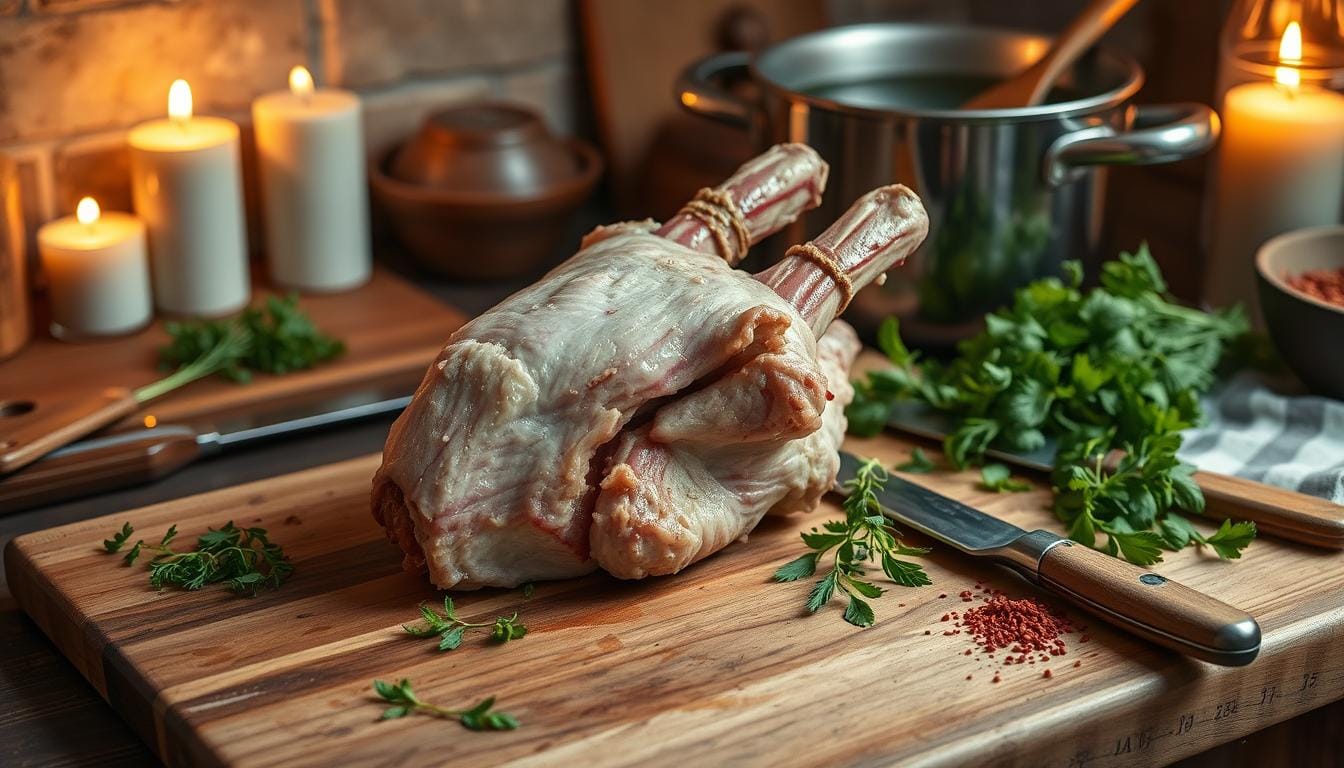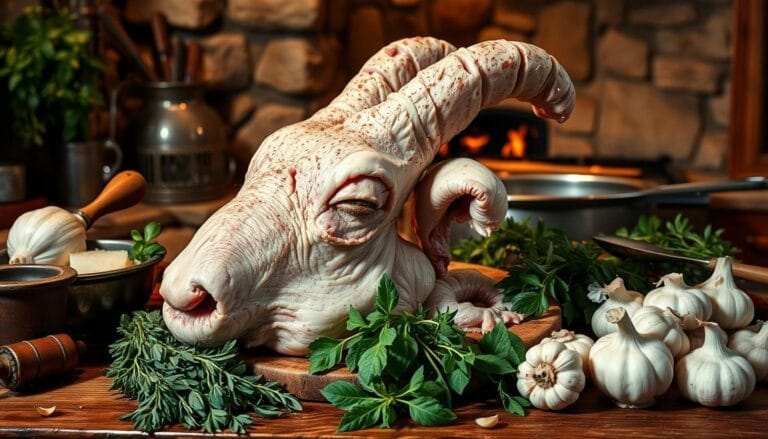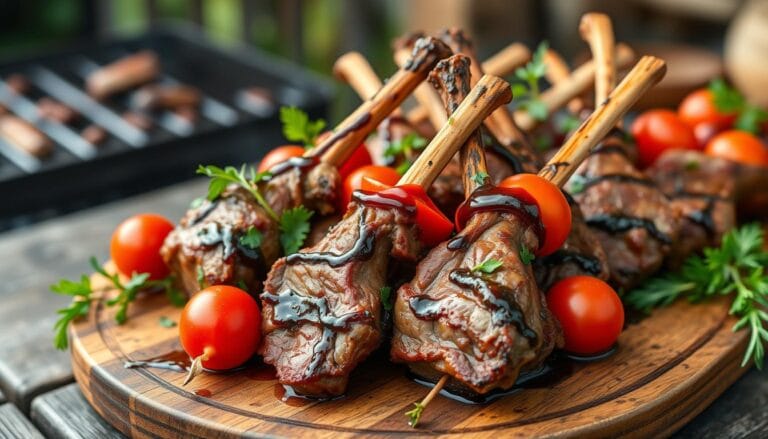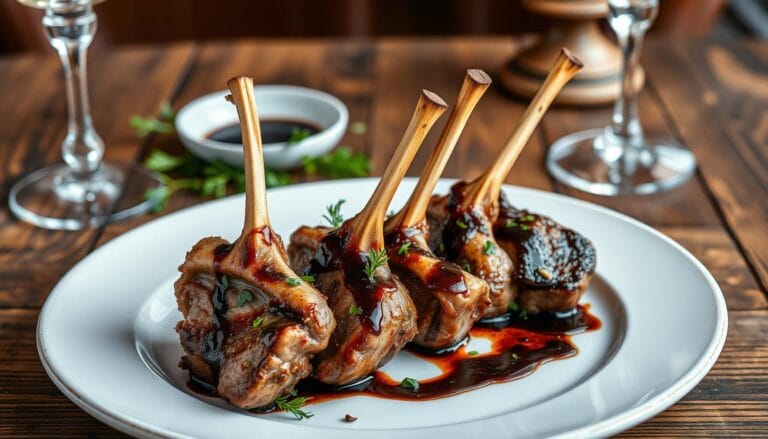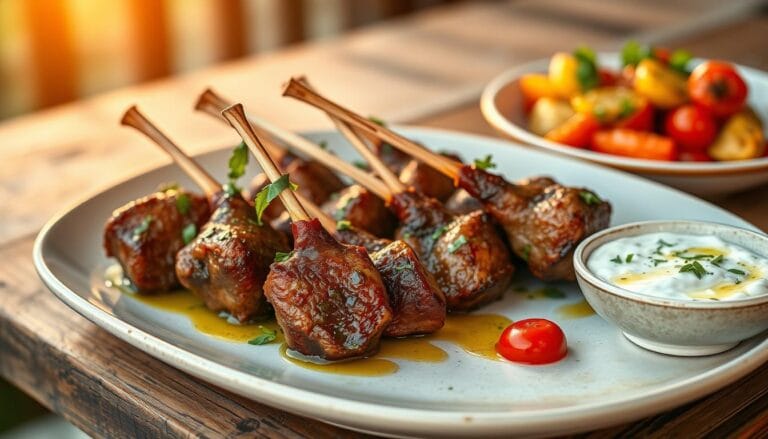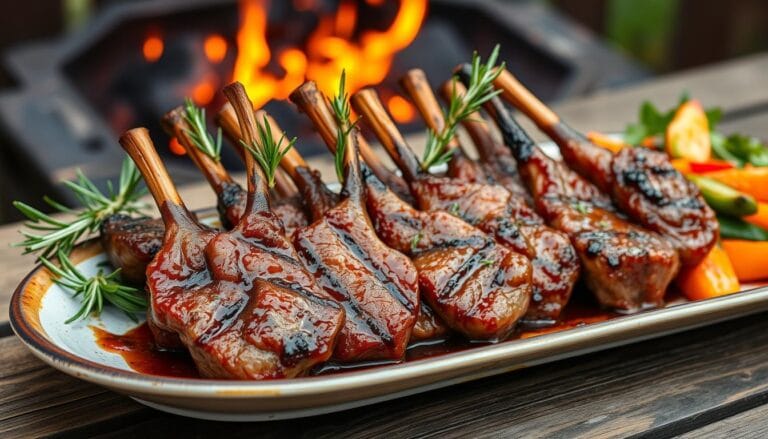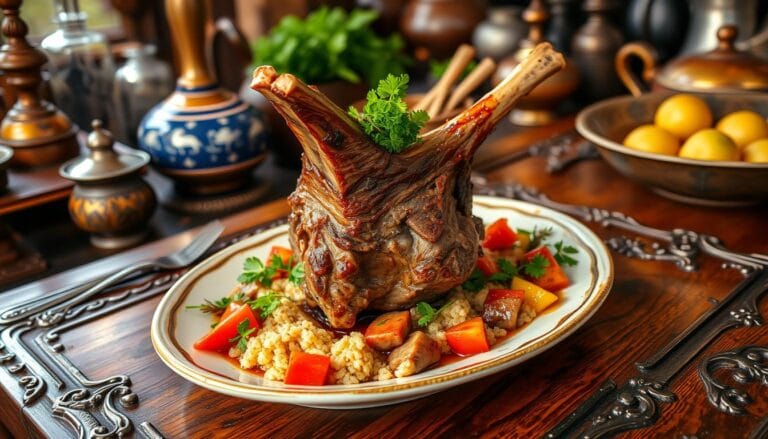How to Cook Lamb’s Head
Growing up in a traditional Middle Eastern family, I remember my grandmother preparing a lamb’s head for a family gathering. The process was intricate and full of cultural significance. It turned an intimidating dish into a masterpiece that united our family.
Cooking lamb’s head is more than a recipe; it’s a journey into a cherished culinary tradition. This dish represents the art of using every part of an animal, showing respect for ingredients. Whether you’re adventurous or curious about ethnic cuisine, cooking a lamb’s head is rewarding.
In this guide, we’ll cover everything you need to know about cooking lamb’s head. We’ll talk about sourcing, cleaning, cooking methods, and flavor combinations. You’ll learn to tackle this unique dish with confidence and enthusiasm.
Key Takeaways
- Learn the cultural significance of lamb’s head in Middle Eastern cuisine
- Discover multiple cooking techniques for preparing lamb’s head
- Understand the nutritional value of this traditional dish
- Master the art of cleaning and preparing lamb’s head
- Explore authentic flavor combinations and serving suggestions
Understanding Lamb’s Head Cooking
Exploring ethnic cuisine shows us amazing cooking traditions. Lamb’s head is a special dish found in many cultures.
Lamb’s head is more than just meat. It has tender parts and gelatinous textures. This makes it a favorite among bold food lovers.
What is Lamb’s Head?
In ethnic cuisine, lamb’s head is a valuable cut. Chefs make sure to use every part. This way, they get the most flavor and nutrition.
- Typically includes cheeks, tongue, and brain
- Preparation varies across different cultural culinary traditions
- Requires specialized cleaning and cooking techniques
Nutritional Benefits of Lamb’s Head
Lamb’s head is full of good stuff for your body. It has lots of protein. This makes it great for healthy meals.
| Nutrient | Amount per 100g |
|---|---|
| Protein | 18-20g |
| Vitamin B12 | 2.5-3.0 mcg |
| Zinc | 4.5-5.5 mg |
Flavor Profile of Lamb
“Lamb’s head captures the essence of traditional cooking – bold, rich, and unapologetically authentic.” – Chef Marco Rodriguez
Lamb’s flavor is strong and earthy. It has a hint of game. When cooked right, it’s tender and rich, showing off the beauty of old cooking ways.
Trying lamb’s head is like going on a journey. You’ll discover real flavors and cooking methods passed down through generations.
Preparation Steps Before Cooking
Exploring whole animal butchery means you need to prepare carefully, especially with a lamb’s head. This method of eating every part of the animal requires precision and respect. Knowing how to clean and prepare it will turn this unique cut into a tasty meal.
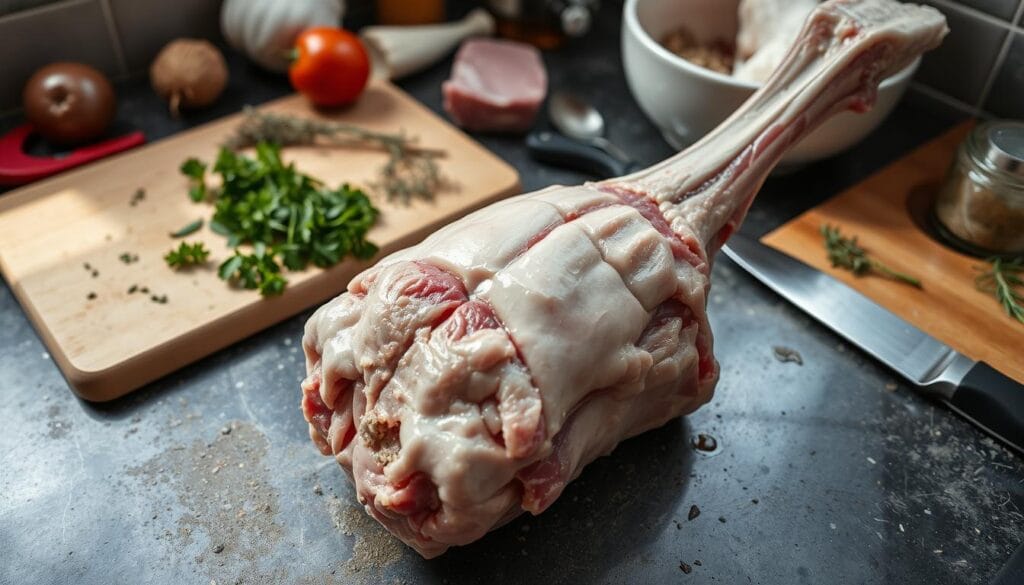
Cleaning the Lamb’s Head
Cleaning is key for safety and flavor. Here’s what to do:
- Rinse the lamb’s head under cold running water
- Remove any visible hair using a clean razor or tweezers
- Scrub the surface gently with a clean brush
- Pat dry with paper towels
Ingredients You’ll Need
For a great nose-to-tail meal, you’ll need the right ingredients. For a basic lamb’s head dish, get:
- Kosher salt
- Fresh ground black pepper
- Garlic cloves
- Fresh herbs (rosemary, thyme)
- Olive oil
Tools and Equipment
Butchery needs specific tools for proper preparation. You’ll need:
- Sharp boning knife
- Large cutting board
- Heavy-duty roasting pan
- Meat thermometer
- Kitchen gloves
“Respect the ingredient, and the ingredient will reward you with incredible flavor.” – Professional Chef
By preparing your lamb’s head well, you’ll enjoy a rich culinary experience. It celebrates traditional cooking and reduces food waste.
Cooking Methods for Lamb’s Head
Exploring different cooking techniques can turn lamb’s head into a true culinary delight. Each method brings out unique flavors and textures. This makes the traditional delicacy a true adventure in the kitchen.
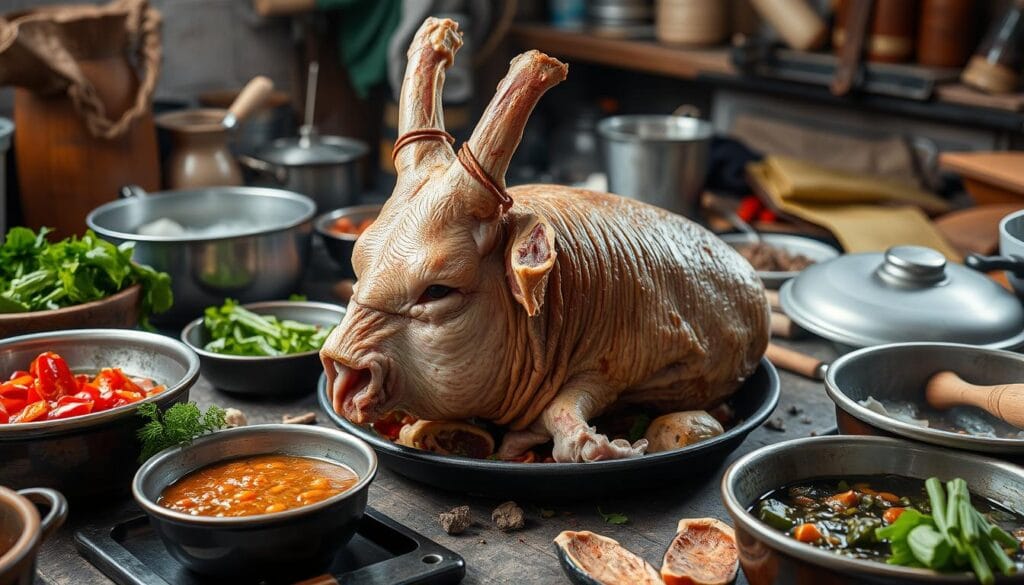
Knowing the right cooking method can make your lamb’s head dish stand out. Let’s look at three main cooking methods to help you master this unique dish.
Braising: A Traditional Approach
Braising is the most authentic way to cook lamb’s head. This slow-cooking method involves:
- Searing the meat to lock in flavors
- Adding liquid like broth or wine
- Cooking at low temperatures for several hours
Grilling for a Smoky Flavor
Grilling gives your lamb’s head a unique smoky taste. Key steps include:
- Using indirect heat to prevent burning
- Maintaining consistent temperature
- Applying robust marinades
Roasting in the Oven
Oven roasting is a simple way to prepare this delicacy. Recommended steps include:
- Preheating the oven to 325°F
- Seasoning generously with herbs
- Monitoring internal temperature
| Cooking Method | Cooking Time | Flavor Profile |
|---|---|---|
| Braising | 3-4 hours | Rich, tender |
| Grilling | 1-2 hours | Smoky, crisp |
| Roasting | 2-3 hours | Crispy exterior, succulent interior |
“Cooking lamb’s head is an art form that connects us to centuries of culinary tradition.” – Chef Marco Rodriguez
Mastering these techniques will help you turn lamb’s head into an incredible dining experience. It celebrates cultural heritage foods and time-honored delicacies.
Recipes to Try with Lamb’s Head
Exploring ethnic cuisine shows the rich traditions of cooking lamb’s head. These recipes highlight the versatility of this unique ingredient. They use different cooking methods and cultural approaches.
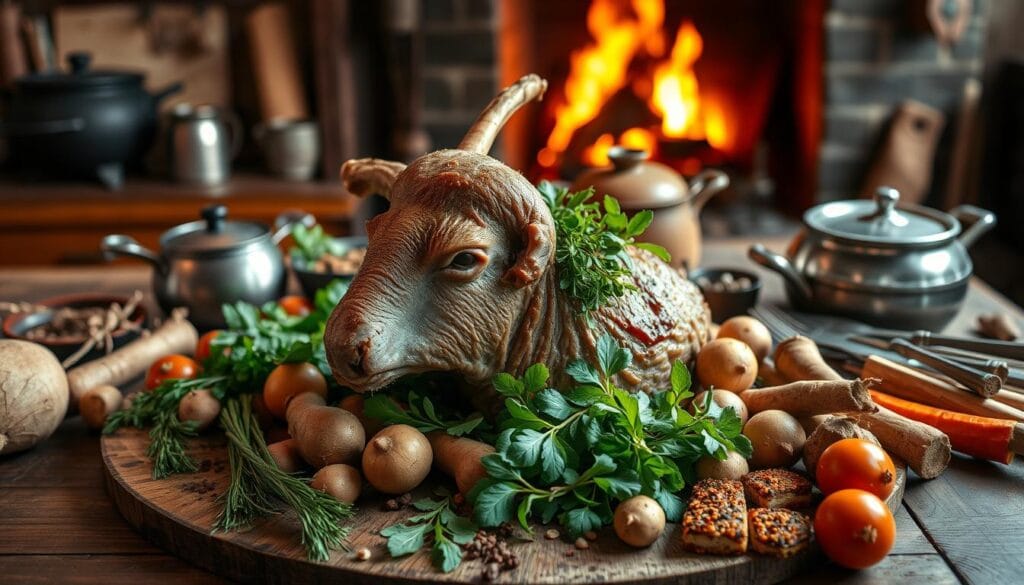
Braised Lamb’s Head Stew
Try a hearty ethnic cuisine classic that turns lamb’s head into a comforting dish. The slow-cooking method makes the meat tender and easy to pull from the bone. You’ll need:
- 1 whole lamb head
- 2 tablespoons olive oil
- 1 large onion, chopped
- 2 carrots, diced
- 4 cloves garlic
- 1 cup dry red wine
- 4 cups beef broth
Cooking tip: Braise at 325°F for 3-4 hours. This ensures the meat is tender.
Grilled Lamb’s Head with Herbs
This method brings out the meat’s natural flavors with herb seasoning. Pro tip: Marinate for several hours to boost the taste.
- Create a herb blend with rosemary, thyme, and oregano
- Score the skin in a crosshatch pattern
- Grill at medium-high heat for even cooking
Roasted Lamb’s Head with Garlic
A classic method that showcases the meat’s rich flavor. Start by roasting at 450°F for 20 minutes. Then, reduce to 325°F for 2-3 hours more.
“Cooking lamb’s head is an art that connects us to ancient culinary traditions.” – Chef Maria Rodriguez
Serve with sides like polenta or mashed potatoes to balance the dish’s richness. Each recipe is a unique journey through ethnic cuisine. It invites you to explore flavors beyond traditional cooking methods.
Flavor Combinations that Work
Turning lamb’s head into a special dish needs the right mix of flavors. Exploring ethnic cuisine, you’ll find herbs, spices, sauces, and veggies that make it stand out.
Herbs and Spices for Flavoring
Choosing the right herbs and spices can make a big difference in lamb’s head taste. Here are some top picks:
- Cumin: A key flavor in Middle Eastern dishes, adding warmth
- Rosemary: Balances the meat’s richness with its strong taste
- Garlic: Brings a deep, aromatic flavor
- Thyme: Adds a mild, earthy touch to the lamb
- Cinnamon: Adds a sweet, complex note
Sauces to Serve with Lamb’s Head
The right sauce can take your lamb’s head to the next level. Try these exciting options:
- Mint yogurt sauce: Offers a cool, refreshing contrast
- Harissa: Adds a spicy North African flavor
- Chimichurri: Brings fresh, herbal notes
- Garlic aioli: Adds creamy richness
Vegetable Pairings
Pair your lamb’s head with veggies that boost its flavor. Here are some great choices:
- Roasted root vegetables
- Grilled eggplant
- Sautéed spinach with garlic
- Pickled veggies for a tangy kick
“The art of cooking lamb’s head lies not just in preparation, but in understanding the symphony of flavors that can elevate this traditional delicacy.”
Serving Suggestions
When serving lamb’s head, think about the culinary traditions and cultural heritage foods. The way you present this dish can make a simple meal into a special experience. It’s a way to honor its rich history.
Presentation Ideas
Focus on making the presentation of lamb’s head both beautiful and respectful. Traditional ways include:
- Putting the whole head in the middle of a big platter
- Decorating with fresh herbs like rosemary and thyme
- Using rustic ceramic dishes to show its cultural importance
Side Dishes to Complement Lamb’s Head
Choosing the right side dishes can make your lamb’s head meal even better. Here are some tasty options:
- Saffron Rice with Pomegranate Seeds
- Roasted Turnips
- Greek Salad with Feta Cheese
- Creamy Parmesan Polenta
“A well-chosen side dish can transform a good meal into an unforgettable culinary experience.”
Wine Pairings
The right wine can bring out the flavors of lamb’s head. Here are some wine pairing suggestions:
- Red Wines: Full-bodied Cabernet Sauvignon
- Medium Wines: Syrah or Grenache
- Lighter Wines: Pinot Noir
Your goal is to create a dining experience that celebrates the deep-rooted culinary traditions of lamb’s head. By focusing on presentation, side dishes, and wine, you’ll make this dish unforgettable.
Common Mistakes to Avoid
Preparing offal dishes like lamb’s head needs precision and care. Whole animal butchery requires attention to detail for a delicious and safe meal. Let’s look at the main mistakes home cooks make when cooking this unique dish.
Overcooking: The Flavor Killer
Overcooking lamb’s head can turn a tender dish into a tough, dry one. It’s important to keep it moist and tender. Cooking times depend on your method:
- Braising: Keep liquid levels consistent
- Roasting: Use a meat thermometer
- Grilling: Watch heat intensity carefully
Never Skip the Cleaning Process
In whole animal butchery, cleaning is a must. Skipping this can lead to:
- Potential bacterial contamination
- Unpleasant flavors
- Food safety risks
“Cleanliness is next to deliciousness in offal dishes.” – Professional Chef
Seasoning: The Art of Balance
Seasoning lamb’s head needs a light touch. You want to add flavor without overpowering it. Use:
- Fresh herbs like rosemary and thyme
- Garlic and black pepper
- Moderate salt levels
Pro tip: Always taste and adjust seasonings gradually to preserve the lamb’s authentic taste.
Storage Tips for Leftovers
Keeping your lamb’s head leftovers fresh is key to enjoying them again. Proper storage helps keep these tasty offal dishes safe and flavorful for multiple meals.
Refrigerator Storage Techniques
Store your lamb’s head leftovers in the fridge for up to 3 days. Use airtight containers to keep moisture in and meat texture good. Always keep the meat at or below 40 degrees Fahrenheit to stop bacteria from growing.
Freezing Recommendations
Freezing is a great way to keep your lamb’s head fresh longer. Here’s how to do it right:
- Use freezer-safe containers for packaging
- Remove air to avoid freezer burn
- Mark containers with the freezing date
- Keep at 0°F or lower
Reheating Best Practices
When reheating, use gentle methods to keep the meat moist and tender. Good reheating techniques include:
- Oven method: Cover with foil and warm at 325°F
- Stovetop: Use low heat with a bit of broth
- Microwave: Heat in short bursts, stirring between
“Proper storage turns leftovers into future meals.” – Culinary Preservation Expert
Freezer Storage Duration
For those who love nose-to-tail eating, knowing freezer limits is important. Cooked lamb can usually be frozen for 2-3 months without losing much quality.
| Storage Location | Maximum Duration | Food Safety Notes |
|---|---|---|
| Refrigerator | 3 days | Keep below 40°F |
| Freezer | 2-3 months | Store at 0°F or lower |
Pro tip: Always trust your senses. If the meat smells bad or looks off, throw it away to avoid food poisoning.
Conclusion
Exploring how to cook lamb’s head opens a door to a world of cooking traditions. These traditions have been passed down for generations. It connects you with old cooking ways that honor whole animals and cultural roots.
Cooking lamb’s head needs patience, skill, and a willingness to learn. You’ve seen how to turn this challenging dish into a tasty meal that celebrates ethnic cuisine. Each method, like braising, grilling, or roasting, brings out the rich flavors of this traditional ingredient.
Your cooking journey doesn’t stop here. Try new seasonings, cooking methods, and ways to present your dishes. Every place has its own way of cooking lamb’s head. Your kitchen can be a place to discover these different cooking traditions. Be brave, trust yourself, and remember that cooking is always a learning process.
Embracing Culinary Adventure
Cooking lamb’s head is more than just making a meal. It’s about understanding cultural ties and broadening your food knowledge. By mastering this dish, you help keep a cooking tradition alive that has fed communities for ages. Your openness to new ingredients shows a deep respect for global food heritage.
FAQ
What exactly is a lamb’s head dish?
A lamb’s head dish is a traditional meal where the whole lamb’s head is cooked. It includes parts like the cheeks, tongue, and brain. This dish is a big part of ethnic cuisines, especially in the Middle East, North Africa, and some parts of Europe.
Is lamb’s head safe to eat?
Yes, lamb’s head is safe to eat if it’s cleaned well and cooked right. It’s important to follow food safety rules. This means cleaning it properly, handling it right, and cooking it to the right temperature to avoid health risks.
What are the nutritional benefits of lamb’s head?
Lamb’s head is full of protein, minerals, and vitamins. It has high-quality protein and important nutrients like iron, zinc, and vitamin B12. It also has collagen and connective tissue, which are good for joints and skin.
What cooking methods work best for lamb’s head?
The best ways to cook lamb’s head are braising, roasting, and grilling. Braising makes the meat tender and flavorful. Roasting gives a crispy outside. Grilling adds a smoky taste. Each method needs special techniques to keep the meat moist and tasty.
How do I clean a lamb’s head before cooking?
To clean a lamb’s head, first remove any hair. Then, wash it with cold water. Next, take out the internal organs and clean the skull cavity. If you’re not comfortable doing this, a professional butcher can help.
What spices and herbs pair well with lamb’s head?
Spice blends like za’atar, ras el hanout, and baharat are great with lamb’s head. Herbs like rosemary, thyme, mint, and parsley also work well. Garlic, cumin, and coriander are popular choices too.
How long can I store cooked lamb’s head?
Cooked lamb’s head can be kept in the fridge for 3-4 days in an airtight container. You can freeze it for up to 2-3 months. Always cool it down properly and use clean containers to keep it safe.
Is lamb’s head considered a delicacy in all cultures?
Lamb’s head is a delicacy in many cultures, especially in the Middle East, North Africa, Mediterranean, and some Central Asian traditions. It’s seen as a special dish in some places and a regular food in others.
What are some challenges in preparing lamb’s head?
Challenges include cleaning it right, cooking it without drying it out, and dealing with its unique texture. Being patient, using the right techniques, and understanding the meat’s nature are key to making a good lamb’s head dish.
Can vegetarians or those with dietary restrictions eat lamb’s head?
No, lamb’s head is not for vegetarians, vegans, or those who don’t eat meat for religious or dietary reasons. Always think about what others might eat when you’re cooking this dish.
Source Links
- https://mynhardt.co.za/recipe/turkish-lambs-head/ – Turkish Lambs Head – Chef Mynhardt
- https://www.tastymeatrecipes.net/best-lamb-head-recipe-ever/ – Best Lamb Head Recipe Ever – Traditional Middle East Dish
- https://whereandwander.com/jemaa-el-fna-best-place-mechoui-alley/ – The Best Place To Eat Mechoui and Sheep Brain In Jemaa El-Fna | Where and Wander
- https://redropefarm.com/sheep/lambing-info/stages-of-lambing-graphic-2/ – Stages of Lambing (graphic photos) – Updated
- https://www.alliedmarketresearch.com/frozen-lamb-market-A323198 – Frozen Lamb Market Size, Share Analysis & Forecast – 2032
- https://www.thewickednoodle.com/how-to-roast-a-whole-lamb-on-a-spit/ – How To Roast A Whole Lamb On A Spit
- https://www.hamisharafi.com/free-recipes/kaleh-pacheh – Kaleh Pacheh Recipe — I got it from my Maman
- https://pitmaster.amazingribs.com/forum/the-pit-mastery-program/lamb-recipes/1563209-does-anyone-have-a-good-capuzzelle-recipe – Does anyone have a good capuzzelle recipe?
- https://www.177milkstreet.com/2024/03/8-delicious-ways-eat-more-lamb – 8 Delicious Ways to Eat More Lamb
- https://www.bookforrecipes.com/best-lamb-head-recipe-ever/ – The Best Lamb Head Recipe Ever
- https://theromaniancookbook.com/romanian-lamb-soup/ – How to Make Romanian Lamb Soup – Ciorba de Miel Recipe – The Romanian Cookbook
- https://www.allrecipes.com/recipe/232474/rack-of-lamb-with-blueberry-sauce/ – Rack of Lamb with Blueberry Sauce
- https://recipeskoukie.com/best-seasonings-for-lamb/ – What seasonings go best with lamb?
- https://www.platingsandpairings.com/lamb-chops-olive-relish/ – Grilled Lamb Chops with Olive Relish
- https://www.delish.com/holiday-recipes/easter/g42642114/side-dishes-for-lamb/ – 40 Side Dishes That Turn Your Lamb Into A Holiday-Worthy Feast
- https://u.osu.edu/sheep/2024/12/10/lambing-and-kidding-cheat-sheet-for-beginning-small-ruminant-producers/ – Lambing and Kidding Cheat Sheet for Beginning Small Ruminant Producers
- https://polingshowsheep.com/polingshowsheepshowtips/ – #PolingShowSheepShowTips
- https://timesofindia.indiatimes.com/life-style/food-news/cooked-meat-storage-in-freezer-guidelines-and-tips/articleshow/107158022.cms – Cooked Meat Storage in Freezer: Guidelines and Tips | – Times of India
- https://www.nutmegnanny.com/garlic-rosemary-roast-leg-lamb/ – Garlic Rosemary Roast Leg of Lamb
- https://www.rd.com/list/meat-storage-guidelines/ – How Long Does Cooked Meat Last in the Fridge?
- https://pmc.ncbi.nlm.nih.gov/articles/PMC10912782/ – Exploring the Ovine Anatomy: A Comprehensive Study of the Sheep’s Head for Basic Training in Functional Endoscopic Sinus Surgery
- https://avmj.journals.ekb.eg/article_376327_292a5f12503fdad56937e369739a0527.pdf – PDF

